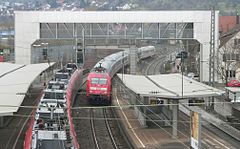|
Schmid PeoplemoverThe Schmid peoplemover (German: Schmid-Peoplemover) is an elevator capable of crossing an obstacle (a road, a railway, a river, etc.). It was invented by Emil Schmid[1] and designed by the company Schmid-Maschinenbau from Sonnenbühl, Germany.[2] Currently ThyssenKrupp Aufzugswerke GmbH is in charge of its maintenance.[3] A cabin with passengers, including wheelchair users, first moves vertically upwards, then horizontally, thus bridging an obstacle, and finally vertically down. Vertical and horizontal trips are connected by a wide, smooth arc. The company claims that its construction is significantly cheaper than an overpass or underpass, occupies less space and it may be installed in 2–3 days from parts fabricated according to different specifications as to height, span, and visual design style.[4] The first Schmid peoplemover was installed in 2001 in Pfullingen (across route B 313). The Pfullingen Peoplemover stopped operating in 2009 due to economic reasons.[1] In 2003 the Ursulabergtunnel opened in Pfullingen, the road no longer was used as a long distance route of high traffic and subsequently downgraded. Traffic lights replaced the people mover. In 2015 it was announced that the nearby city of Reutlingen decided to purchase it and install it at the city hall.[5] However, this was revealed to be an April Fools' Day prank on the next day.[6] Two Schmid peoplemovers exist since 2006 in Altbach in the district of Esslingen[7] and since 2007 at the Berlin-Rummelsburg Betriebsbahnhof station[8] in Berlin and are used to cross railways and grant accessibility to the platform.
See alsoReferencesWikimedia Commons has media related to Schmid Peoplemover.
External links
|
Portal di Ensiklopedia Dunia


